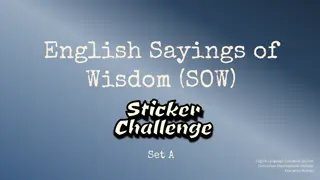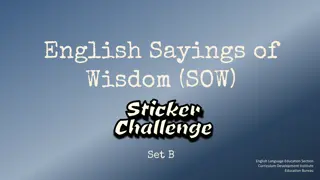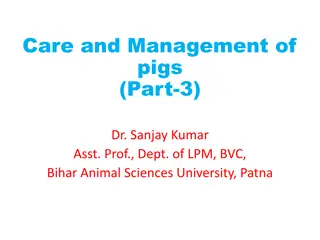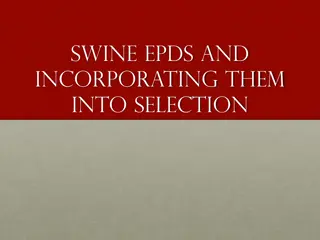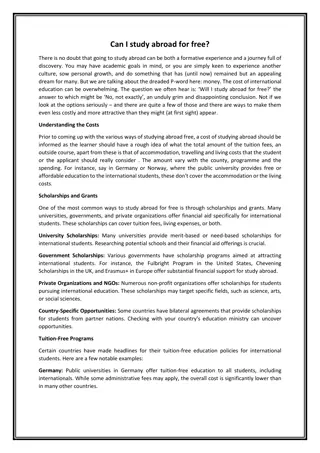
Scheme of Work Development Principles and Key Features
Explore the development of a scheme of work by Stephen Owen & Nick Avery, focusing on integrating NCELP pedagogy, design features, and grammar strands. Understand the general considerations, design format, and objectives of the scheme to master grammar, vocabulary, and phonics knowledge each week.
Download Presentation

Please find below an Image/Link to download the presentation.
The content on the website is provided AS IS for your information and personal use only. It may not be sold, licensed, or shared on other websites without obtaining consent from the author. If you encounter any issues during the download, it is possible that the publisher has removed the file from their server.
You are allowed to download the files provided on this website for personal or commercial use, subject to the condition that they are used lawfully. All files are the property of their respective owners.
The content on the website is provided AS IS for your information and personal use only. It may not be sold, licensed, or shared on other websites without obtaining consent from the author.
E N D
Presentation Transcript
Scheme of work development Stephen Owen & Nick Avery Date Updated: 26/11/19
Todays talk Principles and key features of SoW Walk through of SoW document Presentation of a resource based on SoW Search and find activity
General considerations Integration of the different strands of NCELP pedagogy: grammar, vocabulary and phonics Resourcing to enable delivery of an appropriate KS3 curriculum, in line with this pedagogy Grammar-driven schemes (rather than topic-based) Useable for real-world planning purposes
Design features Common format across languages Context column giving a broad idea of the purpose of the language each week, e.g., Describing a thing or person Notes column containing explanations of the language selected and/or ideas for teaching it Resources columns will contain links to teaching sequences and other items on NCELP Resource Portal
Points to note Objectives for each week in terms of grammar, vocabulary and phonics knowledge to be mastered Schemes are not tiered, but offer scope for differentiation by the teacher Weeks set aside for work on rich texts Revision/assessment weeks in terms 2 and 3 Resourcing of the schemes has begun (available on NCELP resource portal)
Grammar strand (1) Broad parity across languages in terms of key features BUT driven by language-specific characteristics Schemes err on the side of slower progression, allowing for more practice of features introduced Highly frequent irregular verbs form the basis at the start Moving to highly regular and frequent verbs
Grammar strand (2) Greatly reduces 'chunking' of rote-learned language Promotes true manipulation of language Pairs of verb forms (e.g. je versus tu) presented and their meanings contrasted Often introduces and practises features over a two-week period e.g., je, tu and il forms of the verb But pairs of forms contrasted at a time
Grammar strand (3) Re-visiting of grammar in 'Grammar' column Where possible, information gaps in practice activities Activities allow for differing levels of support to be provided
Vocabulary strand (1) 10 new words per week on average Word selection informed by Word frequency largely words in 2000 most frequent Building a verb lexicon from early stages Mixed word classes, allows sentence creation from start But words selected to support the grammar Relevance to grammar and phonics
Vocabulary strand (2) Systematic revisiting at 3 week and 9 week intervals, mainly outside of lessons using CALL Resources recycle previously learnt vocabulary Notes column in SoW identifies opportunities to revisit words that tie in with grammar / context of language use.
Phonics strand (1) Explicit teaching of the key SSCs in each language Short practice slots each lesson (e.g. 10 minutes) French teaches two new SSCs per week Spanish and German present new SSCs individually or in pairs / groups of closely related SSCs, where relevant (e.g. CA, CO, CU) Further suggestions for phonics practice in teacher notes
Phonics strand (2) Source and cluster words used for phonics practice These words are high-frequency and often (near-)cognates Their meanings can be learnt incidentally Some may also be used in a planned vocabulary set
Todays talk Principles and key features of SoW Walk through of SoW document Presentation of a resource based on SoW Exploration of other SoW resources Search and find activity









